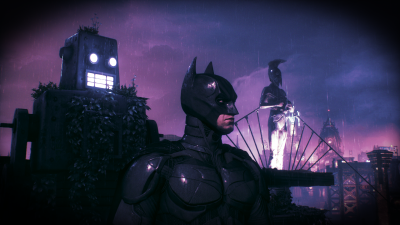
A lot of descriptions have been given to Gotham’s bat-shaped protector over the years: the Caped Crusader, the Dark Knight, or Batsy if you were to ask a certain Joker. At the end of The Dark Knight, James Gordon even says that Batman is “the hero Gotham City deserves.”
Gotham City is the home of Batman, and the Bat-Family place of residence was first identified as Gotham City in Batman #4 (Winter 1940).
In terms of atmosphere, Batman writer and editor Dennis O’Neil has said that, figuratively, “Batman’s Gotham City is Manhattan below Fourteenth Street at eleven minutes past midnight on the coldest night in November.”
Gotham City’s atmosphere took on a lighter tone in the comics of the 1950s and part of the 1960s, similar to the tone of Batman stories of that era. However, by the early 1970s the tone of the city, as well as that of the stories, had become grittier. In recent decades, the portrayal of Gotham has been as a dark and foreboding place rife with crime, grime, and corruption.
Different artists have depicted Gotham in different ways. But they often base their interpretations on various real architectural periods and styles, with exaggerated characteristics, such as massively multi-tiered flying buttresses on cathedrals, or the huge Art Deco and Art Nouveau statuary seen in Tim Burton’s movie version. Within the Batman mythos, the person cited as being influential in promoting the unique architecture of Gotham City during the pre-American Civil War era was Judge Solomon Wayne, Bruce Wayne’s ancestor. His campaign to reform Gotham came to a head when he met a young architect named Cyrus Pinkney. Wayne commissioned Pinkney to design and to build the first “Gotham Style” structures in what became as the center of the city’s financial district. The “Gotham Style” idea of the writers matches parts of the Gothic Revival in style and timing. In a 1992 storyline, a man obsessed with Pinkney’s architecture blew up several Gotham buildings in order to reveal the Pinkney structures they had hidden; the editorial purpose behind this was to transform the city depicted in the comics to resemble the designs created by Nigel Phelps for the 1989 Batman film.
After “No Man’s Land”, Lex Luthor took the challenge of rebuilding Gotham City after the events of “Cataclysm”. Gotham’s old Art-deco and Gothic structures were replaced with modern glass skyscrapers and buildings.
Credit : Fandom
Picture Credit : Google




